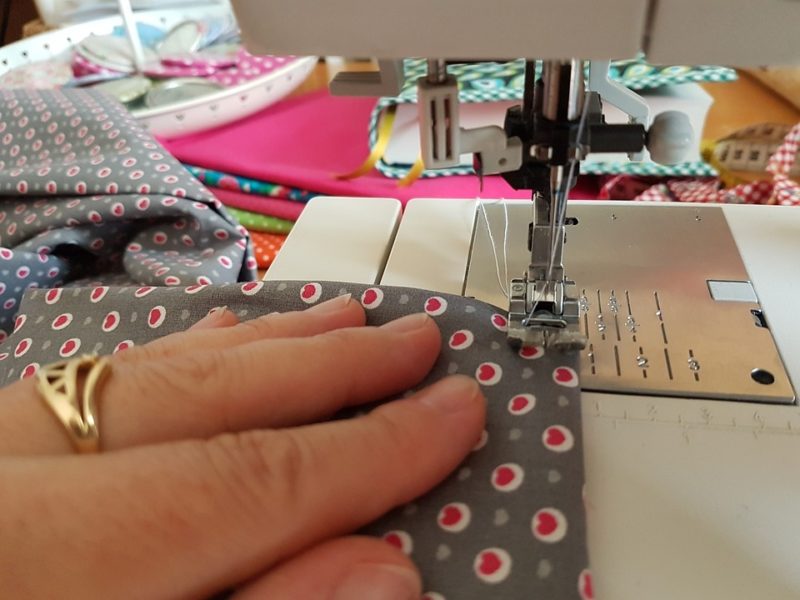You can learn how to use a hemming foot on a sewing machine in just two steps. We’ll talk about everything from enclosing the fabric edge to the sewing itself. You’ll even learn how a hemming foot works after reading this article.
For additional helpful information regarding sewing machine accessories, learn how to set up a sewing machine as well. You can even browse our blog for other tips regarding sewing machine usage.

How Do You Use A Sewing Machine Hemming Foot?
Step 1. Enclose the raw edge
- Cut the fabric edge so that it is even and straight
- Turn the fabric edge twice around ⅛ inches for each fold so that the raw edge becomes enclosed in the fold
- Press the material for the first few inches before lowering the presser foot
- Sew the first two stitches with the fabric fold, not inside the roll of the foot
- Raise the foot lever with the needle still down
Step 2. Start sewing
- Take the turned edge of the fabric inside the hemming foot, then lower the presser foot
- Sew while guiding the material to go inside the roll of the foot
- Hold the thread to the back and control it, so the fabric edge remains inside the roll of the foot when starting from the corner
- Continue working while checking if the fabric fold edge remains in line with the foot guide without stretching the material
How Does A Hem Foot Work?
The hem foot works by producing narrow rolled hems. It has a spiral part where the fabric gets fed and folded over twice. As a result, the raw edge will be hidden, creating a professional finish that protects against fraying since a seam secures the now-folded hem.
You will need to lay the fabric wrong side up to hide the hem since the hem foot will make the rolled hem on the right side of the material. Therefore, the sewer only needs to control the pedal since the hem foot does the most work. To further understand how a hem foot works, feed the edge of the fabric through the foot’s spiral wrong side up and watch how this part produces the folded hem.
What is a hem foot?
The hem foot, also known as the hemmer foot, narrow hem foot, or rolled hem foot, is a type of foot you can use on the sewing machine. With this foot, you can quickly produce narrow hems typically needed for curved hemlines, ruffles, and even delicate fabrics.
Compared to other types of sewing machine foot, you can quickly identify a hemmer foot because it has a curved channel that double folds the raw fabric edge for you, so you don’t need to press the hem yourself.
What Is A Rolled Hem Used For?
- For producing neat narrow hem quickly and efficiently since it presses the hem and stitches them
- For pressing hems on sheer and fine materials that are typically hard to hem manually when sewing
- Ideal for fine and delicate fabrics that might fray easily
- Some sewing projects such as garments and tablecloths will look better with a narrow hem than a wide hem
How Do You Use A Wide Hemming Foot?
Besides the rolled hem foot or the narrow hem foot, there is also the wide hemming foot. It will turn the fabric twice and topstitch the hems quickly and efficiently.
- Press the first three inches of the fabric with an iron and place it under the foot’s curl
- Lower the presser foot down
- Sew then lower the needle before lifting the presser foot
- Manipulate the material around the fabric folder, ensuring that the sewn portion remains under the presser foot
How Do You Use A Hemming Machine?
Most sewing machines come with a blind hem foot to turn them into a hemming machine. This foot allows the machine to make a blind stitch hem where the stitches won’t show outside the fabric. But if your sewing machine doesn’t have its own blind hem foot, you can use your ordinary sewing foot or zigzag foot.
- Press the raw edge by about ¼ inches and press it again by the seam allowance to end up with a hem that is an inch wide
- Fold the hem backward to have around ⅛ inch of material poking out on the edge
- Set the sewing machine to blind stitch for at least two inches wide and two inches long for the stitches
- Place the folded fabric under the machine, so that guide of the blind stitch foot is aligned with the folded edge and sew
Conclusion
And that’s it! To recap how to use a hemming foot on a sewing machine, you’ll start with enclosing the raw edge first, then most of the work will be done by the hemmer foot itself. You can also use a blind hem foot or a wide hemming foot for other types of hems.
Overall, it’s advantageous to get a hemming foot for your sewing machine. Rolled hem has many uses, and having this foot takes out the extra steps in doing it. We hope you learned a lot; let us know if you have questions.
Feel free to read what is serging in sewing for another technique on finishing fabric edges.
